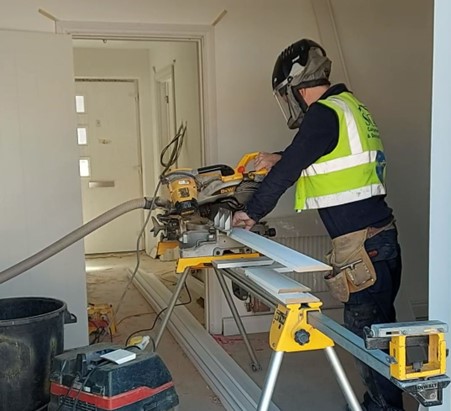
8 Trade Secrets Of Professional Commercial Carpenters
Working as a carpenter in the commercial building sector requires more than just knowing how to use a saw and hammer. The best professionals keep their skills sharp by learning ‘trade secrets’, techniques and tips that help them get the job done efficiently and accurately – without compromising on safety or quality. This formidable skill and knowledge base, when combined within a contracting business, is one of the most compelling reasons for working with a professional commercial carpentry partner when planning a new building development – as opposed to simply hiring carpenters independently. Here are eight such ‘trade secrets’ that professional commercial carpenters use to stay ahead of their game.
1. “Measure Twice, Cut Once”
This old adage is still as true today as when we learned it from older carpenters when we were still green apprentices – despite all the digital and electronic aids now available to carpenters! Taking extra time to make sure that your measurements are exact will save you time in the long run and ensure that your cuts are precise. It also reduces materials wastage by avoiding errors since you have double-checked the measurement before making a cut. For construction project managers and clients, this saves valuable time and money.
2. Have All The Tools On Hand
Having multiple types of tools to hand can be invaluable for any professional carpenter working in commercial construction, as you never know when an unexpected challenge will arise that may require a different approach. A professional carpenter will ensure that he or she arrives on site with all the necessary equipment for each job so they don’t find themselves without an essential tool halfway through a project. Over the course of a project, this can save days of wasted time spent sourcing the right tools or ‘making do’ with what’s available.
3. Use A Power Saw For Precision Cuts
Bench saws, mitre saws, table saws and chop saws provide for precision cuts which can be replicated with minimal effort and are equally as effective in the workshop or on site. Construction-grade portable power saws are ideal for making straight cuts with precision accuracy because they’re designed to ensure that each cut is exact, repeatable and consistent throughout the whole process. This saves time re-measuring joins and going back to make adjustments once cuts have already been made.
4. Secure Your Work
When working with wood or other materials, it’s important to secure your work before making any cuts or drilling holes into it. Using clamps prevents movement while you work, ensuring accuracy and safety when using power tools, such as drills, driversand saws. This is a crucial safeguard for operator safety on site, lowering the risk of accidents and damage to tools and materials. It also cuts down on waste, improving project efficiency and reducing costs.
5. Use the Right Fixings
Different fixings are used for different applications; never assume one type will work for everything! An experienced professional commercial carpenter will know which nails are suitable for each task, so that their finished product looks good, is securely fitted and lasts longer than if they used an unsuitable nail, screw or other fixing type or size. Always read the manufacturer’s fixing recommendations as a mistake early in a project might result in an expensive remedial at a later date. This is one of the important reasons that professionally finished carpentry jobs have a higher quality assurance rating than tasks completed by a less experienced tradesperson.
6. Work Efficiently
A professional carpenter will use numerous methods to maximise efficiency. These include the use of jigs and templates, as well as pre-preparing materials in batches, cutting multiple copies of the same items for use later in the process. This avoids the need to re-measure and repeat work at a later stage.
7. Familiarise Yourself with Building Regulations, Standards and Specifications
Different developers and clients have different building specifications and there are a wide number of health and safety and quality standards that apply to commercial carpentry, so a key job of a professional commercial carpenter is to familiarise his or herself with all the applicable standards, drawings and specifications before beginning a project. This precaution minimises costly mistakes mid project due to incorrect installation or non-compliance with regulations, while also improving site safety. By hiring a contractor business that already has knowledge of the applicable regulations, you’ll also save time training and onboarding your contractors before they start work.
8. “Practice Makes Perfect”
Last but by no means least, all professional commercial carpenters must take time to practice their skills if they want to become better at what they do. This only comes with time, and many on-site skills can’t easily be acquired in the classroom. Practicing hands on carpentry techniques in the context of a diverse and experienced team can help improve essential skills such as accuracy and speed, leading to higher quality and a faster work rate.
Next Steps
To find out more about our commercial carpentry services and why working with a professional business like SC4 can make all the difference to cost-effective project delivery, please contact us today.
Click on the categories below to find out more about:

Connect with Us
Share this Page
More Posts
Recent Posts
- Breathe Easy, Work Safe: The RPE Every Site Worker Needs
- From Site to Strategy: Simon Mead Promoted to Associate Director at SC4
- SC4 named Cala Contractor of the Month, October 2025
- Why is Neurodiversity so important in Construction?
- Our Favourite Carpentry Project Of 2024: Cromwell Court, Old Basing
- Case Study: Timber Frame Installation in Netley Grange, Southampton
